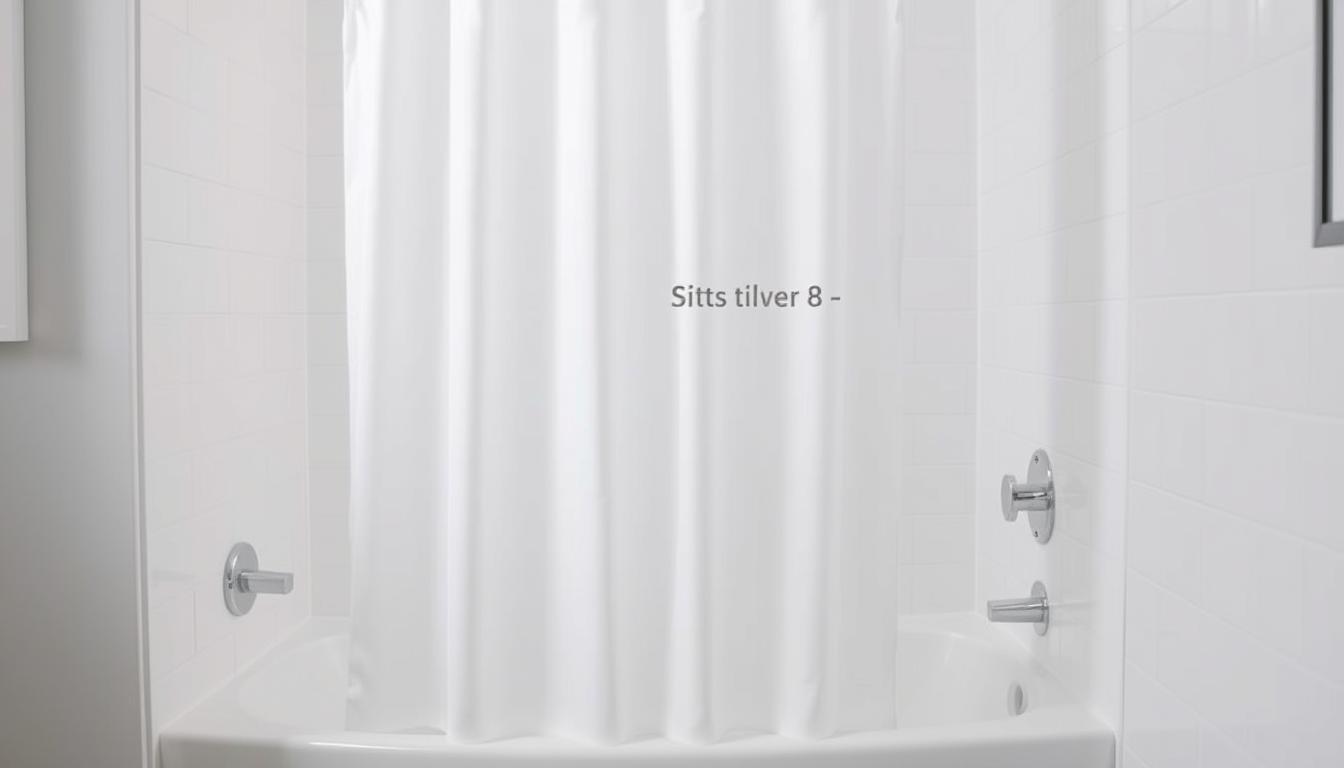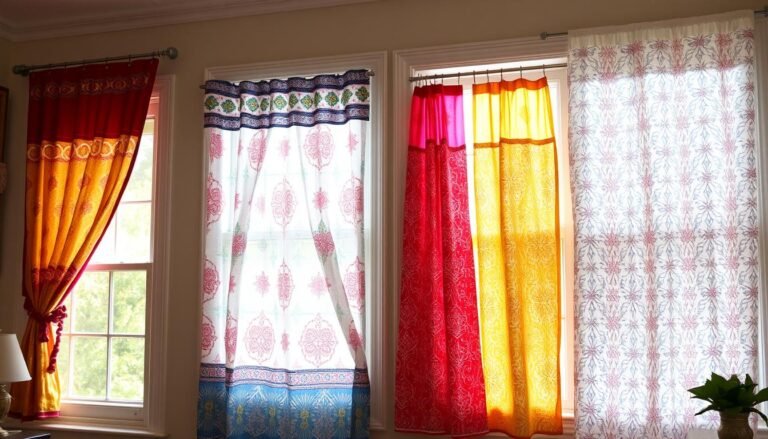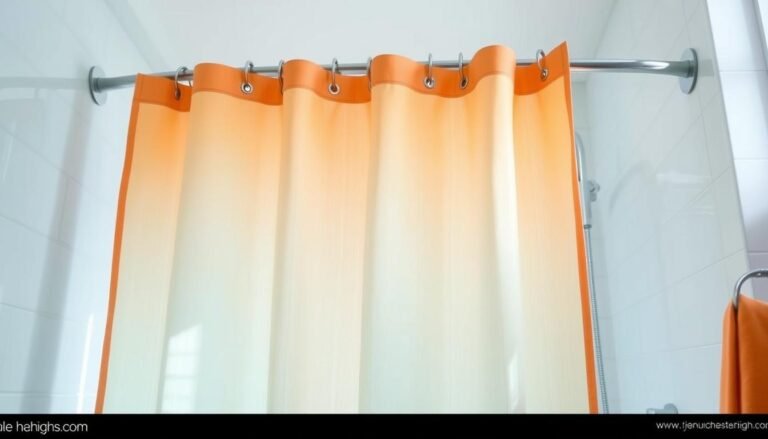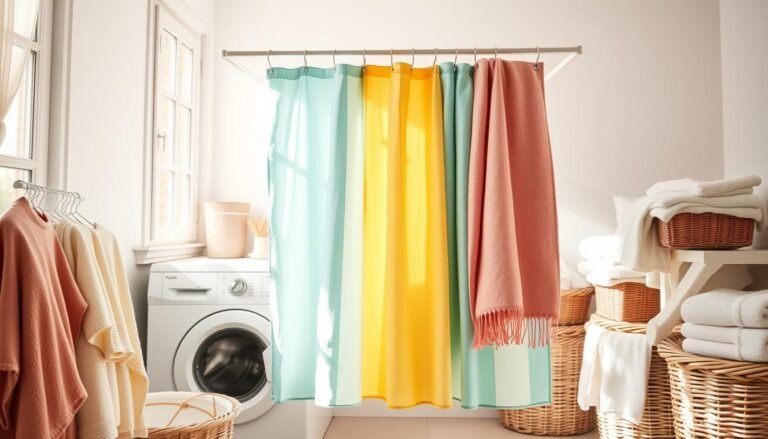Standard Shower Curtain Length: What You Need to Know
Choosing the right shower curtain can transform your bathroom instantly. It’s important to know the standard shower curtain length for both function and style. The most common size is 72″x72″, but you can find curtains in sizes like 70″x70″ or 74″x74″ too.
Getting the right size prevents water from spilling out of the shower. This keeps your bathroom floor dry and clean. Most US bathtubs fit these standard curtain sizes, making them practical for any home. For unique showers, like tall or walk-in types, look for sizes like 96″x72″ or 54″x78″.
Adding the right liner and accessories, such as rings or rods, improves your curtain’s function and look. Remember to add 3 inches to the curtain’s height for the rings and rod. For more tips, visit this comprehensive guide.
Measuring your shower area ensures you get the perfect curtain size. Whether it’s a new addition or an update, knowing the standard shower curtain length is key. It can greatly affect your bathroom’s overall look.
Understanding Standard Shower Curtain Sizes
Choosing the right size for your shower curtain is key. It’s not just about how it looks. The correct size makes sure your bathroom stays dry and functions well.
Common Measurements for Shower Curtains
The usual size for a shower curtain is 72 x 72 inches. This fits most showers in homes. But, there are other sizes like 70 x 70 inches, 74 x 74 inches, 96 x 72 inches, and 90 x 72 inches. They help fit different bathroom styles.
For shower stalls and walk-in showers, sizes like 54 x 72 inches or 54 x 78 inches are best. If you have a clawfoot tub, you’ll need a wider curtain. A size of 180 inches by 72 inches will cover the tub properly and prevent water from splashing out.
| Type of Shower | Common Sizes (in inches) |
|---|---|
| Standard Bathtub | 72 x 72, 70 x 70 |
| Extra-long Tub | 96 x 72, 90 x 72 |
| Shower Stall | 54 x 72, 54 x 78 |
| Clawfoot Tub | 180 x 72 |
Why Size Matters
Choosing the right size shower curtain is crucial. The wrong size can cause problems. For example, a too short curtain lets water out. A too wide one can look messy and be a tripping risk.
Standard sizes like 72 x 72 inches fit well with a 60-inch tub. Remember to add 3 inches for the rod and rings. The curtain should also be 12 inches wider than the shower to keep water in.
In short, picking from standard shower curtain sizes helps your bathroom look and work better. It cuts down on clean-up and keeps your space tidy.
How Long is a Normal Shower Curtain?
Choosing the right shower curtain length is essential. The ideal length is usually 72 inches for a standard bathroom. There are different lengths to fit various setups.
Standard Lengths Explained
Most bathtubs are about 60 inches long. So, shower curtains around 70 x 70 inches or 72 x 72 inches work well. These sizes cover the tub properly.
Shower stalls or walk-in showers use curtains sized 54 x 72 inches or 54 x 78 inches. For those who are taller or want extra coverage, curtains can be as long as 96 x 72 inches or 90 x 72 inches.
| Type of Shower | Required Curtain Size |
|---|---|
| Standard Tub | 72 x 72 inches |
| Shower Stall | 54 x 72 inches |
| Extra-Tall Shower | 72 x 84 inches |
| Extra-Wide Shower | 144 x 72 inches |
| Clawfoot Tub | 180 x 72 inches |
Determining the Best Length for Your Bathroom
To find the best shower curtain length, measure from the rod to the floor. Then, subtract 10 inches to keep it off the ground. This leaves a gap of 2-5 inches above the floor, which is perfect.
Another thing to think about is where the curtain rod is placed. Also, consider the kind of rings to use. This ensures the curtain not only looks good but works well too.
Measuring for the Perfect Fit
Finding the right fit for your shower curtain is key. It should hang neatly and cover your shower fully. We’ll guide you to achieve the best fit.
Step-by-Step Measuring Guide
Know the standard shower curtain size first. Common sizes are 72″ x 72″ and others like 70″ x 70″. For longer curtains, sizes go up to 96″ x 72″. For shower stalls, 54″ x 72″ curtains are usual. Remember to add 12 inches to the width for proper draping.
Width Considerations
To measure width, go wall to wall across the shower. If you have a rod, measure between its brackets. Clawfoot tubs use 180 inches wide curtains. Freestanding tubs might need 12 extra inches in width.
Height Considerations
Measure height from the rod to the floor. Take off 8-10 inches to avoid a curtain that’s too long or short. With curtain rings, for a 72 inches long curtain, set the rod at 75 to 77 inches high. Getting the height right is important for looks and use.
Customizing measurements ensures your curtain fits well. This keeps your bathroom dry and stylish. For tips on pool cover care, see this guide here.
| Standard Shower Curtain Sizes | Common Uses |
|---|---|
| 72″ x 72″ | Most common, fits standard tubs |
| 70″ x 70″ | Smaller tubs, spaces |
| 96″ x 72″ | Extra-long for taller areas |
| 54″ x 72″ | Shower stalls, walk-in showers |
| 180″ x 72″ | Clawfoot tubs |
By noting these measurements, you ensure a perfect fit for your shower curtain. It will look great in your bathroom.
Choosing the Right Shower Curtain Material
When you pick a shower curtain material, think about how it will look and how easy it will be to keep clean. You can choose from vinyl, cotton, or even hookless designs. Each type has its own benefits to consider.
Vinyl vs. Fabric
Vinyl curtains are budget-friendly and simple to care for. They block water well and can be made to resist stains better. Fabric curtains, like those made from cotton or polyester, come in many styles. They make your bathroom look nicer but need a liner to keep water and mildew away.
| Material | Pros | Cons |
|---|---|---|
| Vinyl | Water repellent, low-cost, easy to clean | Less breathable, fewer design options |
| Fabric (Cotton/Polyester) | Variety of designs, breathable | Requires a liner, higher maintenance |
Cotton, Decorative, and Hookless Options
Cotton curtains add a classy feel to your bathroom. You can find them in many styles, like solids or prints. They usually need a liner to avoid water damage, though.
Decorative curtains add beauty to your bathroom. They have special designs and fine materials. For them to handle moisture well, you should use a liner.
Hookless curtains are a newer design that is easy to set up. They have grommets built in so you can hang them without rings. This makes your bathroom look neat.
- Vinyl shower curtains: Ideal for low-maintenance, cost-effective solutions
- Cotton shower curtains: Perfect for those seeking elegance and breathability
- Decorative shower curtains: Excellent for adding a touch of luxury and style
- Hookless shower curtain: Best for convenience and ease of installation
Tips for Maintaining Your Shower Curtain
Keeping your shower curtain in good shape is key. It makes your bathroom look clean and stops mold and mildew from growing. Here are some simple steps for taking care of your shower curtain.
Cleaning and Care Instructions
For fabric shower curtains, clean them every three months. You can use everyday items like detergent, vinegar, and bleach for cleaning. If you can’t machine wash, then hand-washing is best.
Vinyl and plastic curtains need a wash every one to two months. Throw them in the washing machine with a few white cotton towels. This helps scrub them without causing wrinkles. A mix of vinegar and water also works well for cleaning. Wash shower liners made of polyester, nylon, or vinyl in hot water and soap or bleach once a month.
Preventing Mold and Mildew
Stopping mold and mildew is critical. After washing your curtain, let it dry in the air. Use an exhaust fan to keep air moving and stop bacteria. Don’t forget about the curtain rings. Clean them with vinegar and warm water or bleach to remove mold.
For step-by-step guidance on regular maintenance, check out this comprehensive article. A clean curtain and liner make your bathroom look better and are healthier for you.
| Frequency | Items | Instructions |
|---|---|---|
| Every 3 Months | Fabric Shower Curtain | Machine wash with white vinegar or baking soda |
| Every 1-2 Months | Vinyl/Plastic Shower Curtain | Wash with cotton towels on delicate cycle |
| Monthly | Shower Liner | Machine wash on delicate with soap/bleach |
| As Needed | Shower Curtain Rings | Soak in vinegar and warm water or clean with bleach solution |
By sticking to these cleaning steps and schedule, your shower curtain will stay in great shape. It’ll be free of mold and mildew, too.
Accessorizing Your Shower Curtain
Accessorizing your shower curtain boosts your bathroom’s look and function. You’ll find many accessories like liners, rods, and rings. Correctly choosing these items not only makes your bathroom look better. It also ensures your shower curtain works well.
Importance of Shower Curtain Liners
Shower curtain liners are essential for keeping your curtains in good shape. They shield curtains from water and prevent mildew growth. This is especially key for fabric curtains. Liners help them stay dry and last longer. Vinyl liners are favored for their long life and easy care.
Most shower curtains are 72 x 72 inches, fitting most tubs well. Your liner should fall three inches past the rod for full coverage. Some liners also have weights to keep curtains in place, stopping them from moving too much during showers.
Choosing Rings and Rods
Shower curtain rings and rods add beauty and function to your space. When picking rings, think about their material and look. Stainless steel and plastic are common because they work well. Make sure your rings move easily on the rods. This makes opening and closing simple.
Setting your shower curtain rods at the right height is important. It should allow three inches for the curtain and rings. This setup keeps the curtain and liner from leaking water outside the tub.
Rods come in finishes like chrome and brushed nickel. Pick a finish that matches your bathroom’s look for a unified design. Choose materials that resist rust in damp areas. With the right rod and accessories, your bath will look classy and well put together.
Choosing the right rods and rings can make your bathroom look and work better. This careful matching improves both the room’s style and function.
Special Considerations for Non-Standard Showers
Non-standard showers like shower stalls, walk-in showers, and RV showers need the right shower curtain. They often require curtains that are extra-tall or extra-wide. This is to prevent water from escaping. For showers without frames, matching the modern look with curtains can make your bathroom look better.
Extra-Tall and Extra-Wide Curtains
In larger showers or unique spaces, the right curtain size is important. Extra-tall curtains keep water inside, especially with high ceilings. In smaller showers, you might need to trim plastic curtains or shorten fabric ones to fit.
Extra-wide curtains are great for larger shower areas. They keep water from getting out, which keeps your bathroom clean and safe.
Shower Stalls and Walk-In Showers
Shower stalls and walk-in showers can be small or large, fitting different needs. Small showers need to keep water in to avoid damage. This is very important in RV showers where you don’t have much room.
Larger showers like wet rooms need a good design to be easy to use and clean. Frameless doors help these spaces seem bigger and more modern. Consider features like grab bars or shower seats for those who need them.
For more about ADA-compliant showers, including where to put controls, check out Burnham Nationwide.

Hey there, I’m Alex Hanson and I’m passionate about all things covers! Whether you’re looking for a car seat cover to protect your vehicle or an oven cover to keep your kitchen clean, I’m here to help. With years of experience in the industry, I have plenty of knowledge and insights to share with my readers. So, if you care about protecting your belongings and making them look their best, you’re encouraged to read my blog as I explore the perfect cover for every need.







